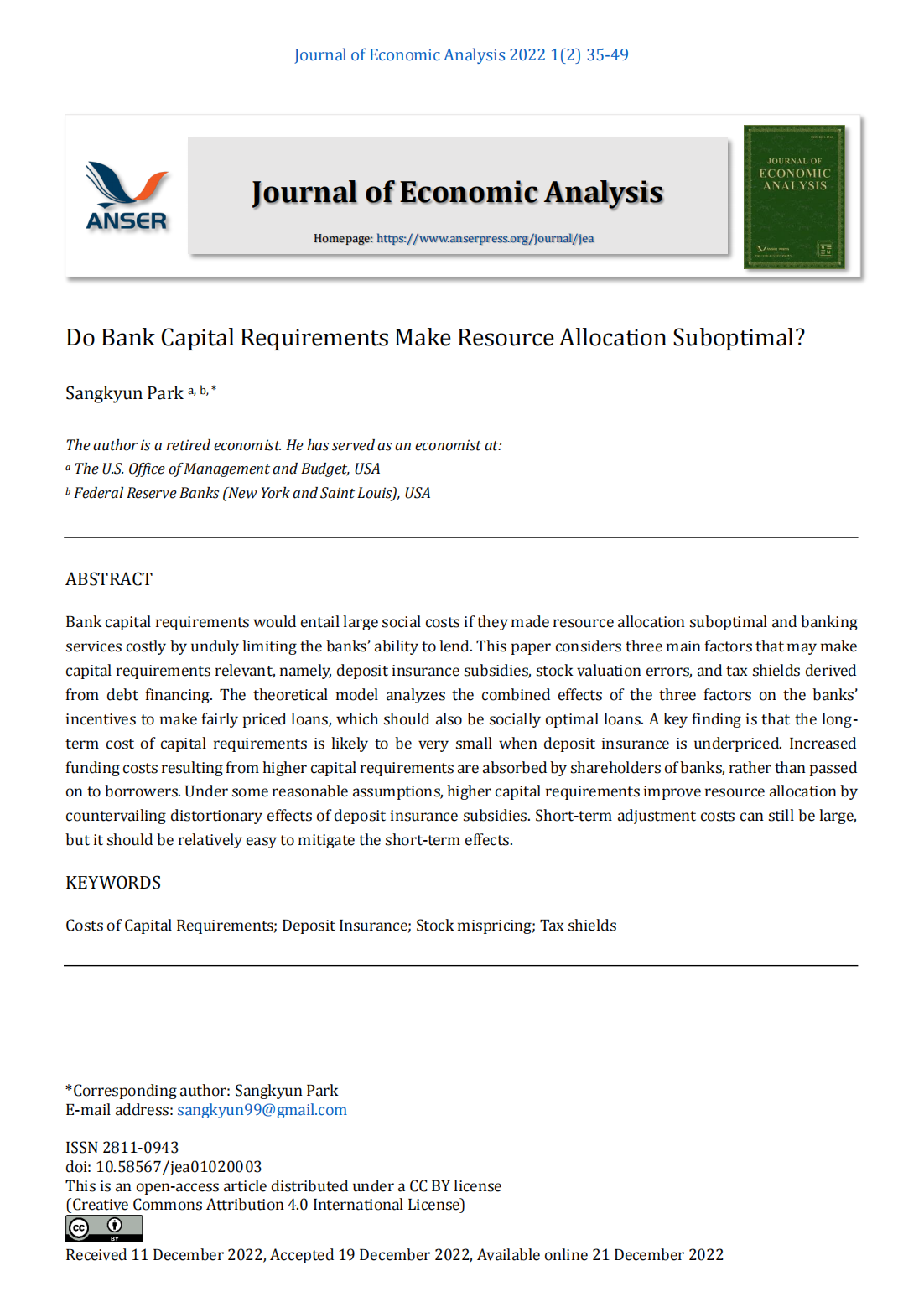Do Bank Capital Requirements Make Resource Allocation Suboptimal?
DOI:
https://doi.org/10.58567/jea01020003Keywords:
Costs of Capital Requirements, Deposit Insurance, Stock mispricing, Tax shieldsAbstract
Bank capital requirements would entail large social costs if they made resource allocation suboptimal and banking services costly by unduly limiting the banks’ ability to lend. This paper considers three main factors that may make capital requirements relevant, namely, deposit insurance subsidies, stock valuation errors, and tax shields derived from debt financing. The theoretical model analyzes the combined effects of the three factors on the banks’ incentives to make fairly priced loans, which should also be socially optimal loans. A key finding is that the long-term cost of capital requirements is likely to be very small when deposit insurance is underpriced. Increased funding costs resulting from higher capital requirements are absorbed by shareholders of banks, rather than passed on to borrowers. Under some reasonable assumptions, higher capital requirements improve resource allocation by countervailing distortionary effects of deposit insurance subsidies. Short-term adjustment costs can still be large, but it should be relatively easy to mitigate the short-term effects.
References
Alfon, I., Andrews, P. (1999). Cost-Benefit Analysis in Financial Regulation, Journal of Financial Regulation and Compliance 7 (4), 339-352. https://doi.org/10.1108/eb025021
Almenberg, Johan, Markus Andersson, Daniel Buncic, Cristina Cella, Paolo Giordani, Anna Grodecka, Kasper Roszbach, and Gabriel Söderberg. (2017). Appropriate capital ratios in major Swedish banks – new perspectives, Sveriges Riksbank Staff Memo. https://www.riksbank.se/globalassets/media/rapporter/staff-memo/engelska/2017/staff_memo_170519_eng.pdf
Angelini, P., L. Clerc, V Curdia, L. Gambacorta, A. Gerali, A Locarno, R. Motto, W. Roeger, S. Van den Heuvel, and J. Vicek. (2011). Basel III: Long-term Impact on Economic Performance and Fluctuations, BIS Working Papers No. 338. https://doi.org/10.1111/manc.12056
Basel Committee on Bank Supervision. (2010). An Assessment of the Long-Term Economic Impact of Stronger Capital and Liquidity Requirements, Bank for International Settlements Working Paper.
Basel Committee on Banking Supervision. (2019). The costs and benefits of bank capital – a review of the literature, Bank for International Settlements Working Paper.
Chan, Yuk-Shee, Stuart I. Greenbaum, and Anjan V. Thakor. (1992). Is Fairly Priced Deposit Insurance Possible? Journal of Finance 47 (1), 227-245. https://doi.org/10.1111/j.1540-6261.1992.tb03984.x
Cline, William R. (2017). The right balance for banks: Theory and evidence on optimal capital requirements, Columbia University Press. https://lccn.loc.gov/2016035251
Elyasiani, Elyas and Lawrence G. Goldberg. (2004). Relationship Lending: A Survey of the Literature, Journal of Economics and Business 56 (4), 315-30. https://doi.org/10.1016/j.jeconbus.2004.03.003
Goodhart, Charles A.E., Anil K. Kashyap, Dimitrios P. Tsomocos, and Alexandro P. Vardoulakis. (2011). Financial Regulation in General Equilibrium, Working Paper, University of Chicago. https://www.nber.org/papers/w17909
Hanson, Samuel G., Anil K. Kashyap, and Jeremy C. Stein. (2011). A Macroprudential Approach to Financial Regulation, Journal of Economic Perspectives 25 (1), 3-28. https://doi.org/10.1257/jep.25.1.3
Kashyap, Anil K., Jeremy C. Stein, and Samuel G. Hanson. (2010). An Analysis of the Impact of ‘Substantially Heightened’ Capital Requirements on Large Financial Institutions, Working Paper, University of Chicago. https://scholar.harvard.edu/files/stein/files/impact_of_substantially_heightened.pdf
Merton, Robert C. (1977). An analytic derivation of the cost of deposit insurance and loan guarantees, Journal of Banking and Finance 1 (1), 3–11. https://doi.org/10.1016/0378-4266(77)90015-2
Modigliani, Franco and Merton H. Miller. (1958). The Cost of Capital, Corporation Finance and the Theory of Investment, The American Economic Review 48 (3), 261-297. http://www.jstor.org/stable/1809766
Myers, Stewart C. and Nicholas S. Majluf. (1984). Corporate financing and investment decisions when firms have information that investors do not have, Journal of Financial Economics, 13(2), 187–221. https://doi.org/10.1016/0304-405X(84)90023-0
Park, Sangkyun. (1996). Banking and Deposit Insurance as a Risk-Transfer Mechanism, Journal of Financial Intermediation 5 (3), 284-304. https://doi.org/10.1006/jfin.1996.0016
Park, Sangkyun. (1997). Risk-taking behavior of banks under regulation, Journal of Banking and Finance 21(4), 491–507. https://doi.org/10.1016/S0378-4266(96)00050-7
Park, Sangkyun. (2002). Put Option Values of Thrifts in the 1980s: Evidence from Thrift Stock Reactions to the FIRREA, Journal of Financial and Quantitative Analysis 37(1), 157-176. https://doi.org/10.2307/3594999
Van den Heuvel, Skander J. (2008). The Welfare Cost of Bank Capital Requirements, Journal of Monetary Economics 55 (2), 298-320. https://doi.org/10.1016/j.jmoneco.2007.12.001

Downloads
Published
How to Cite
Issue
Section
License
Copyright (c) 2022 Sangkyun Park

This work is licensed under a Creative Commons Attribution 4.0 International License.



